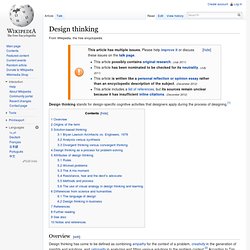

Waters Foundation. Design thinking. Design thinking stands for design-specific cognitive activities that designers apply during the process of designing.[1] Overview[edit] Design thinking has come to be defined as combining empathy for the context of a problem, creativity in the generation of insights and solutions, and rationality in analyzing and fitting various solutions to the problem context.[2] According to Tim Brown, CEO and president of IDEO, the goal of Design Thinking is "matching people’s needs with what is technologically feasible and viable as a business strategy" [3] The premise of teaching Design Thinking is that by knowing about how designers approach problems and the methods which they use to ideate, select and execute solutions, individuals and businesses will be better able to improve their own problem solving processes and take innovation to a higher level.

Origins of the term[edit] (For a detailed evolution, see History, below.) Solution-based thinking[edit] Bryan Lawson Architects vs. Lawson found that: Design thinking and startups: A good match? I was interviewed by Victor Helmre, a Master’s student writing a thesis as part of a program called Business & Design – a collaboration between a design school and a business school in Gothenburg, Sweden. He’s looking at how startups can benefit from design. What is your definition of Design? First and foremost, for me design is solving problems in the most elegant way – good design should barely go noticed.
To me there are several layers to design, but if you don’t get the basics right everything else is secondary. I believe the best design balances beauty and simplicity. Why help startups/entrepreneurs? In my experience they often don’t see value in investing in design, particularly early on. In what ways can they benefit from design? In CEO speak, higher revenues. To me good design isn’t just about aesthetics or function, it’s about the emotional connection we make with the people we’re designing for. Would you call what you talk about to startups and entrepreneurs as “design thinking”? How context shapes content: Rodney Mullen at TEDxUSC. Creative Thinking Is a Specific Process That Can Be Replicated.
Double Loop Learning Presentation by Benjamin Mitchell. Posted on October 8, 2012 Comments (0) Benjamin Mitchell – Using the Mutual Learning Model to achieve Double Loop Learning from Agileminds.

Benjamin Mitchell presents ideas using Chris Argyris thinking on double-loop learning. “Double-loop learning occurs when error is detected and corrected in ways that involve the modification of an organization’s underlying norms, policies and objectives.” Single loop learning is basically to just try again using the same understanding, thinking and tactics. It is understood that the results were not what was desired so we will try again, but the supporting system is not seen as the reason results were not the desired results. Argyris: people will blame others and the system when their actions seem to differ from their espoused proper actions. Related: People are Often Irrational – Double Loop Learning in Organizations by Chris Argyris – Theory of knowledge – Rethinking or Moving Beyond Deming Often Just Means Applying More of What Dr.